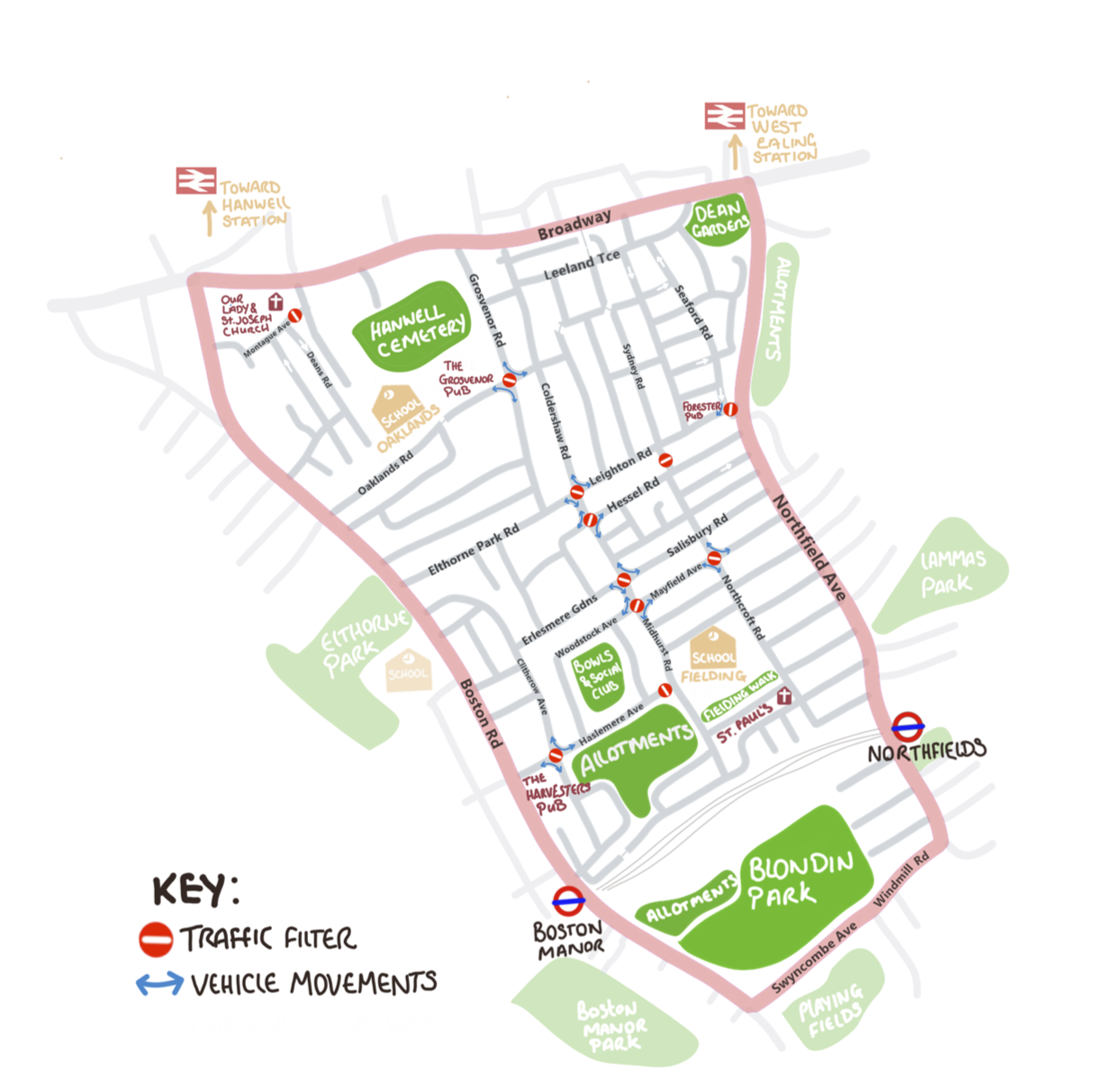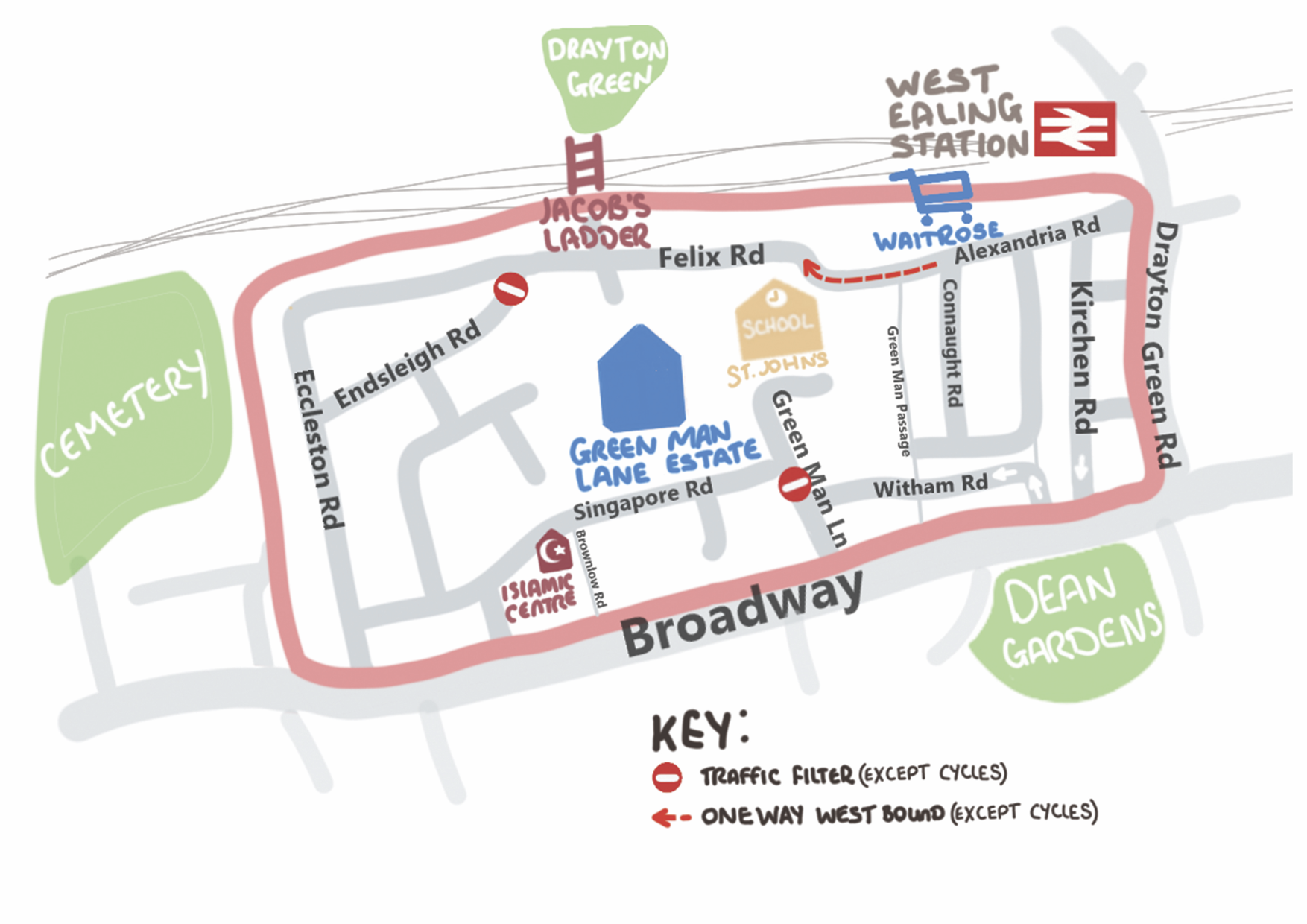The latest news regarding the Live West Ealing project. To stay up to date with information straight to your inbox sign up to receive updates here.
Latest News
Archived News Items
Update on Dean Gardens Workshop with local artist Chidi3sProject Update
For the past 2 years we have been developing the Live West Ealing project to transform your streets and green spaces. However, work on the proposals are on hold as we focus our attentions on the response to the COVID-19 emergency.
National Government has instructed Local Authorities to reallocate road space for significantly increased numbers of cyclists and pedestrians. The Department for Transport outlined a series of measures to help encourage more people to choose alternatives to public transport when they need to travel, making healthier habits easier. Transport for London issued guidance called ‘Streetspace for London’ which sets the context for London and highlights Low Traffic Neighbourhoods (LTNs), where residential streets are closed to through traffic, as a key component to ensure that Londoners can chose to travel in a manner that is healthy and safe. The need for social distancing is likely to extend until at least the end of 2020 and both government and TfL advice is to avoid public transport unless absolutely necessary and to walk or cycle where possible.
The guidance from National Government and TfL notes that measures should be taken as swiftly as possible. As part of Ealing’s response to the pandemic we are creating new Healthy Neighbourhoods throughout Ealing. Two of these Healthy Neighbourhoods includes the network of streets to the north and south of Broadway.
West Ealing South LTN
Installation of the LTN south has now been completed. Situated in the wards of Elthorne, Walpole and Northfields, this proposed Healthy Neighbourhood is bounded by the Broadway to the north and Blondin Park in the south while Boston Road and Northfield Avenue make up the west and east boundary respectively. These roads comprise the boundary for the LTN because they are designed to carry high volumes of traffic, as well as heavy goods vehicles and buses.
The road network within those boundary roads provides motorists with several options for cutting through the neighbourhood. There are existing filters in place on St. Kilda Road and Sydney Road and they ensure those roads remain quiet. However, that is not enough to solve the traffic problem for the whole neighbourhood as the traffic gets displaced onto adjacent streets that are not meant to carry large amounts of traffic. Similarly, if a traffic filter was placed on Leighton Road, traffic would be displaced onto adjoining streets such as Hessel Road, Balfour Road etc. Therefore it is necessary to take a more strategic approach which looks at removing through traffic from the entire residential area, keeping it on major roads.
This area includes the original LTN project for Live West Ealing.

View a larger version of the map.
As part of that original LTN project we ran an online survey and held a number of events at the Welshore Hub throughout December and January. There was a clear desire to find workable solutions to what is widely considered to be a significant problem associated with the volume and speed of traffic in the neighbourhood. The results of the online survey which closed in January as well as the details of the engagement activities can be read in the following report.

Members of the community explore design solutions at a co-design workshop at the Welshore Hub in January this year.
The need to address these traffic problems is potentially greater now because as the current lockdown loosens there is a real risk that the car will become the default mode of transport which will lead to more traffic in the neighbourhood making it less safe for pedestrians and cyclists. Therefore, it is necessary to deliver this project as soon as possible. Installation of the LTN south has now been completed.
West Ealing North LTN
Situated in the ward of Elthorne, this Healthy Neighbourhood is bounded by the Broadway to the south and the railway to the north while Eccleston Road and Drayton Green Road will make up the west and east boundaries respectively. Installing modal filters in this area was originally proposed as part of Live West Ealing to eliminate traffic cutting through the neighbourhood so as to avoid using Broadway. Due to the existing banned turn from Drayton Green Road on to Broadway it is necessary to accommodate westbound traffic. Therefore, a one-way westbound between Alexandria Road and Felix Road is required. A contraflow cycle lane will be included at this location to enable people to cycle safely in both directions. Additional filters on Green Man Lane and Endsleigh Road will further reduce through traffic.

View a larger version of this map.
West Ealing LTN north is now due to be implemented on 21st September. All residents will be notified of works via post one week before installation.
The LTNs will be created for an initial 6 month period using temporary traffic barriers in the form of planters and bollards including central collapsible bollard for emergency vehicles as well as signage letting drivers know where there is no through access. This will create a safer and more pleasant environment for people to travel on foot or by bike enabling them to access the shops on Broadway, the train and underground stations at West Ealing, Northfields and Boston Manor as well as local schools and numerous green spaces and allotments.
Reducing Traffic while Maintaining Access
Bin lorries and deliveries will still be able to access your property. Depending on the layout of your street, they will either be able to drive through your street, turn around or reverse down the street (as they already do on some streets). The emergency services are key stakeholders and support the delivery of Low Traffic Neighbourhoods. The ambulance services, police and fire brigade have been consulted on the proposed road changes to ensure essential access can be maintained.
Filter location is decided by a number of factors. These include:
- Retaining vehicle access to all properties.
- Minimising the cost of the scheme by minimising the number of filters.
- Placing filters towards the centre of the neighbourhood, where possible, to minimise inconvenience to car journeys ensuring residents can drive to their nearest boundary road.
- Using diagonal filters, where possible, to create loops which minimise the need for three-point turns or reversing, especially by larger vehicles.
For more information on low traffic neighbourhood design, Sustrans have produced a guide.
As evidenced in the Waltham Forest LTN, there may be an initial small increase in traffic on the surrounding main roads. However, the traffic that is removed from the LTN does not all end up on the surrounding main roads and this is due to people adjusting their travel behaviour. This means some people will stop making certain trips, or choose to travel at alternative times, or combine multiple trips, while some people will choose to walk or cycle. This may not be an option for some people therefore it is important that every address within the LTN is still accessible by car. Some journeys may take longer and we recognise that people may be inconvenienced by some of the changes, but Healthy Neighbourhoods are for everyone – and it is important to consider the large portion of residents who do not drive, and who deserve to feel safe on their streets and protected from the negative impacts of exposure to motor traffic.
Benefits of Traffic Reduction
Busy and congested roads within neighbourhoods provide an immediate and apparent threat to our health in the form of air pollution, and current research shows this contributes to the number of coronavirus infections as well as the severity of the outcome. A key way to reduce air pollution in London is to prioritise walking, cycling and public transport over the private car.
Physically inactive lifestyles are contributing to deteriorating physical and mental health. Only one third of adults in London are doing the 20 minutes of brisk activity a day recommended by Public Health England, and 56% of adults are overweight or obese. As a result we’re seeing rising rates of chronic illnesses such as Type 2 diabetes and cardiovascular disease – both of which significantly increase risk for Covid-19 patients.
Congested roads sever communities and reduce social cohesion. Environments that are pleasant to walk through promote socialising with your neighbours by encouraging residents to spend more time outside getting to know one another. LTNs help create better public spaces and healthier and happier residents. When through traffic is removed, people enjoy travelling through their neighbourhoods without the noise and danger of traffic dominance. LTNs also protect the most vulnerable road users (young/older people, pedestrians and cyclists) from immediate and long term traffic risks.
Monitoring the Scheme
The interventions are being implemented as a trial, and will be in place for an initial 6 month period. As well as monitoring and assessing the impact on the wider road network we will be collecting your feedback throughout the 6 month period. Trialling the design to see how it works will allow for the design to be changed if required as all the interventions during the trial phase will be relatively easy to move. If the trial is successful, we will work on developing and delivering a permanent scheme, which will be informed by your feedback and lessons learned from the temporary scheme.
If you wish to comment on this scheme you can contact Ealing’s transport team via email at this address: COVIDtransport@ealing.gov.uk
50% off bicycle parking in West Ealing
Live West Ealing will be subsidising hangar spaces by 50% for the first 12 months, so a bicycle space will cost £36 per year rather than £72. What’s more, if you already rent an existing space Live West Ealing will subsidise your space for a year upon renewal! Find out more.
Award Winners!
Live West Ealing won the Healthy Streets Proposal of the Year Award on Wednesday 9 October 2019. The award is for the best proposals that take in to account the healthy streets indicators set by TfL. These indicators could be met through: street design, access, active travel choices, safety, improved air quality and livability. Read more…
Get interactive with Hello Lamp Post!
In line with the release of the Masterplan Survey on Live West Ealing, the team have partnered up with Hello Lamp Post to provide an innovative way for people to share their feedback. Hello Lamp Post turn everyday street items into talking objects so that residents can give their opinions and ideas on the street and public spaces. Find out more.
For more information regarding our plans for West Ealing please contact livewestealing@ealing.gov.uk



